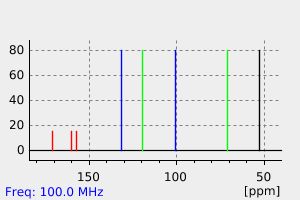methyl 3-(allyloxy)isoxazole-5-carboxylate | 205115-28-2
中文名称
——
中文别名
——
英文名称
methyl 3-(allyloxy)isoxazole-5-carboxylate
英文别名
methyl 3-allyloxyisoxazole-5-carboxylate;methyl 3-prop-2-enoxy-1,2-oxazole-5-carboxylate
CAS
205115-28-2
化学式
C8H9NO4
mdl
——
分子量
183.164
InChiKey
FPWNKJATAPESMD-UHFFFAOYSA-N
BEILSTEIN
——
EINECS
——
-
物化性质
-
计算性质
-
ADMET
-
安全信息
-
SDS
-
制备方法与用途
-
上下游信息
-
文献信息
-
表征谱图
-
同类化合物
-
相关功能分类
-
相关结构分类
物化性质
-
沸点:298.4±25.0 °C(Predicted)
-
密度:1.178±0.06 g/cm3(Predicted)
计算性质
-
辛醇/水分配系数(LogP):1.5
-
重原子数:13
-
可旋转键数:5
-
环数:1.0
-
sp3杂化的碳原子比例:0.25
-
拓扑面积:61.6
-
氢给体数:0
-
氢受体数:5
上下游信息
-
上游原料
中文名称 英文名称 CAS号 化学式 分子量 3-苄氧基异噁唑-5-羧酸甲酯 3-benzyloxyisoxazole-5-carboxylic acid methyl ester 205115-22-6 C12H11NO4 233.224
反应信息
-
作为反应物:描述:methyl 3-(allyloxy)isoxazole-5-carboxylate 在 正丁基锂 、 三聚氯氰 、 氨 作用下, 以 四氢呋喃 、 hexanes 、 乙醚 、 水 、 N,N-二甲基甲酰胺 为溶剂, 反应 18.97h, 生成 tert-butyl 3-(3-(allyloxy)-5-cyanoisoxazol-4-yl)-2-(bis(tert-butoxycarbonyl)amino)propanoate参考文献:名称:AMPA 受体的光致变色激动剂摘要:光开关:AMPA 受体的光致变色激动剂 ATA-3(见方案),可以说是最重要的一类离子型谷氨酸受体,显示具有亚型选择性,在黑暗中激活 AMPA 受体 GluA2,并在受到照射时迅速关闭带蓝绿光。它可用于有效控制哺乳动物大脑中的神经元活动。DOI:10.1002/anie.201109265
-
作为产物:描述:3-苄氧基异噁唑-5-羧酸甲酯 在 N-溴代丁二酰亚胺(NBS) 、 偶氮二异丁腈 、 potassium carbonate 作用下, 以 四氯化碳 、 丙酮 为溶剂, 反应 5.5h, 生成 methyl 3-(allyloxy)isoxazole-5-carboxylate参考文献:名称:3-羟基异恶唑保护基团的评估 - 3-烷氧基异恶唑-5-甲醛和 3-羟基异恶唑-5-甲醛(Muscimol 的推定有毒代谢物)的短期访问摘要:研究了 3-羟基异恶唑-5-酯 1 在 O- 与 N-烷基化方面的区域选择性。3-O-烷基产物 2 受苄基、二苯甲基和烯丙基溴 (≥ 91:9) 的青睐,这与 5-烷基-3-羟基异恶唑的已知用途或使用重氮甲烷(或甲基碘)进行甲基化形成对比. 甲氧基甲基化仅产生 N-取代的异恶唑啉酮 3e。用 DIBAH 还原后,酯 2 得到 3-O-保护的 3-羟基异恶唑-5-甲醛 4 (75-98%)。为了去除苄基保护基团,发现三种变体(HBr/HOAc、H2-Pd/BaSO4、NBS/AIBN)可用于 5-酯、5-甲酰基和 5-羟甲基衍生物。相应地制备了游离 3-羟基-5-甲醛 9,即 GABA 激动剂 muscimol 的假定毒性代谢物。DOI:10.1002/(sici)1099-0690(199803)1998:3<473::aid-ejoc473>3.0.co;2-v
文献信息
-
[EN] SUBSTITUTED AMINOTHIAZOLES AS DGKZETA INHIBITORS FOR IMMUNE ACTIVATION<br/>[FR] AMINOTHIAZOLES SUBSTITUÉS UTILISÉS COMME INHIBITEURS DE LA DGK ZÊTA POUR L'ACTIVATION IMMUNITAIRE申请人:BAYER AG公开号:WO2021214020A1公开(公告)日:2021-10-28The present invention covers aminothiazole compounds of general formula (I) : in which R1, R2, R3 and R4 are as defined herein, methods of preparing said compounds, intermediate compounds useful for preparing said compounds, pharmaceutical compositions and combinations comprising said compounds and the use of said compounds for manufacturing pharmaceutical compositions for the treatment and/or prophylaxis of diseases, in particular of diacylglycerol kinase zeta (DGKζ) regulated disorders, as a sole agent or in combination with other active ingredients.
-
HETEROCYCLIC COMPOUND申请人:Fimecs, Inc.公开号:EP4006037A1公开(公告)日:2022-06-01It is to provide a novel heterocyclic compound which has the effect of inducing degradation of interleukin-1 receptor-associated kinase-M (IRAK-M) protein and is expected to be useful for the prevention/treatment of cancer, fibrosis, infectious diseases, etc. The present invention provides a compound represented by the following formula (I) or a pharmaceutically acceptable salt thereof.本发明旨在提供一种新的杂环化合物,具有诱导白细胞介素-1受体相关激酶M(IRAK-M)蛋白降解的效果,并有望用于预防/治疗癌症、纤维化、传染病等。本发明提供一种由以下公式(I)表示的化合物或其药学上可接受的盐。
表征谱图
-
氢谱1HNMR
-
质谱MS
-
碳谱13CNMR
-
红外IR
-
拉曼Raman
-
峰位数据
-
峰位匹配
-
表征信息
同类化合物
(反式)-4-壬烯醛
(s)-2,3-二羟基丙酸甲酯
([1-(甲氧基甲基)-1H-1,2,4-三唑-5-基](苯基)甲酮)
(Z)-4-辛烯醛
(S)-氨基甲酸酯β-D-O-葡糖醛酸
(S)-3-(((2,2-二氟-1-羟基-7-(甲基磺酰基)-2,3-二氢-1H-茚满-4-基)氧基)-5-氟苄腈
(R)-氨基甲酸酯β-D-O-葡糖醛酸
(5,5-二甲基-2-(哌啶-2-基)环己烷-1,3-二酮)
(2,5-二氟苯基)-4-哌啶基-甲酮
龙胆苦苷
龙胆二糖甲乙酮氰醇(P)
龙胆二糖丙酮氰醇(P)
龙胆三糖
龙涎酮
齐罗硅酮
齐留通beta-D-葡糖苷酸
鼠李糖
黑芥子苷单钾盐
黑海棉酸钠盐
黑木金合欢素
黑曲霉三糖
黑介子苷
黄尿酸8-O-葡糖苷
麻西那霉素II
麦迪霉素
麦芽糖脎
麦芽糖基海藻糖
麦芽糖1-磷酸酯
麦芽糖
麦芽四糖醇
麦芽四糖
麦芽十糖
麦芽六糖
麦芽五糖水合物
麦芽五糖
麦芽五糖
麦芽五糖
麦芽三糖醇
麦芽三糖
麦芽三糖
麦芽三塘水合
麦芽七糖水合物
麦芽七糖
麦法朵
麦可酚酸-酰基-Β-D-葡糖苷酸
麦利查咪
麝香酮
鹤草酚
鸢尾酚酮 3-C-beta-D-吡喃葡萄糖苷
鸡矢藤苷







